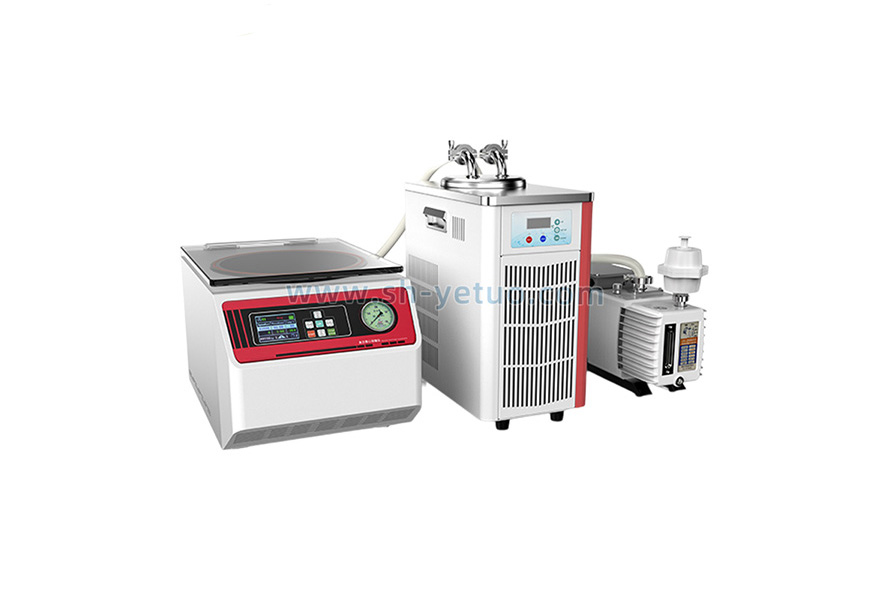Although the principle and operation process of the Shanghai Yetuo vacuum centrifugal concentrator are relatively clear, in order to achieve efficient, comprehensive, and non-destructive concentration treatment, it is still necessary to pay attention to some details during use. The following "Concentrator Usage Guide" may help you avoid detours and improve experimental efficiency.
1、 The sample volume and tube type selection should match
Do not add too much sample. It is recommended to control the sample volume within 1/2~2/3 of the centrifuge tube capacity to avoid liquid splashing during high-speed centrifugation.
For different models of equipment, suitable centrifuge tubes, PCR tubes, or microplates should be used to prevent shaking or imbalance during centrifugation, which may affect the vacuum state.
It is recommended to use sealed microtubes or configure cold traps for volatile samples to prevent loss.
2、 The inspection of the vacuum linkage system cannot be omitted
Before use, please check whether the vacuum pump and connecting pipelines are well sealed; Any small leak can seriously affect vacuum efficiency, leading to concentration failure or significantly prolonged time.
Regularly clean the cold trap or trap to prevent secondary pollution or blockage caused by the accumulation of volatile solvents.
Some organic solvents (such as chloroform, methanol, etc.) are corrosive. It is recommended to use a Kang corrosion type vacuum pump and regularly replace the filter.
3、 The temperature setting should vary depending on the sample
Thermally sensitive samples (such as nucleic acids and enzymes) are recommended to be set at room temperature or below 30 ℃, and ensure that the centrifuge chamber is equipped with a cooling and ventilation system or an ice box.
If the concentrated sample is water or ethanol aqueous solution, it can be appropriately increased to 45 ℃~60 ℃ to accelerate evaporation, but attention should be paid to avoiding overheating of the sample.
It is recommended to set a uniform temperature based on the most "fragile" samples.
4、 Ensure sample balance before centrifugation
Like ordinary centrifuges, vacuum centrifugation also requires symmetrical balance, with the same number of samples placed on both sides.
If the number of samples is odd, an empty tube and equilibrium solution can be used to simulate symmetrical placement.
Unbalance can cause unstable rotation, affect centrifugal efficiency, and even damage the rotor.
5、 The concentration process should be monitored throughout the entire process
When using for the first time, it is recommended to manually observe the first few minutes to ensure that the vacuum is established normally and the speed is stable.
Pay attention to whether there is sample splashing onto the centrifuge tube wall or lid, and adjust the time/power/vacuum rate to control it.
Some devices support transparent top covers or built-in monitoring, allowing real-time viewing of sample status and timely intervention.
6、 The concentrated sample should be immediately stored or analyzed
The concentrated sample is usually a viscous liquid or dry residue, which is prone to moisture absorption or oxidation.
It is recommended to immediately seal it with a sealing cover, or proceed directly to the next step of operation such as re suspension, machine testing, freezing, etc.
If not used immediately, it can be stored at -20 ℃ or -80 ℃ as needed to avoid repeated freezing and thawing.
7、 Maintenance and upkeep are equally important
Check the sealing ring, rotor, and inner wall of the cavity of the equipment weekly for any residual liquid or signs of corrosion.
Clean the inner cavity and centrifuge tray once a month to keep them dry and prevent mold growth or moisture in the circuit.
Regularly calibrating the speed and vacuum system helps to maintain concentration efficiency and sample consistency in the long term.
Conclusion:
Equipment is dead, operation is alive.
The efficiency and results of Shanghai Yetuo vacuum centrifugal concentrator not only depend on its technical parameters, but also on the user's control over details.
Take every centrifuge tube and temperature setting seriously in order to truly protect the "scientific research samples" you have painstakingly collected at the molecular level.


 Alibaba Store
Alibaba Store Tmall Store
Tmall Store Jingdong Sstore
Jingdong Sstore







